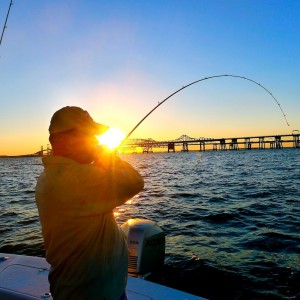 When it comes to selecting a rod, light tackle fishermen are rightfully very picky. Most of us get very specific about what we like. You’ll find several websites that have great information about choosing a multi-purpose fishing rod, but I don’t know of many that focus specifically on the best rods for casting lures on the Chesapeake Bay. There is always an element of personal choice when it comes to rod selection, and less experienced anglers should use basic and less-expensive equipment, but if you’re serious about the light tackle game, here are six things (and maybe a few more) you need to know:
When it comes to selecting a rod, light tackle fishermen are rightfully very picky. Most of us get very specific about what we like. You’ll find several websites that have great information about choosing a multi-purpose fishing rod, but I don’t know of many that focus specifically on the best rods for casting lures on the Chesapeake Bay. There is always an element of personal choice when it comes to rod selection, and less experienced anglers should use basic and less-expensive equipment, but if you’re serious about the light tackle game, here are six things (and maybe a few more) you need to know:
1. Baitcasting Benefits – Once you see a baitcaster used effectively for catching stripers, you’ll never go back to a spinning outfit. Baitcasters are appropriate for most jigging situations in the Chesapeake Bay. Wind and current can make a boat drift rapidly across a good jigging spot. As you drift across and away from the fish, your lure will be pulled up, over and above the strike zone. With a baitcaster, you simply press the thumb bar to let your lure fall back down to the proper depth. Unlike with a spinning reel, you don’t have to cast again. Keep in mind that, through most of the year, the bigger stripers are usually close to the bottom, so you increase your chances of catching them by keeping the lure where they are. Here’s a link to a video I shot in July a few years ago at the Bay Bridge. It shows some useful baitcasting techniques and includes some shots of resetting a lure into the strike zone. https://www.youtube.com/watch?v=sH_3rC0sZ-Y
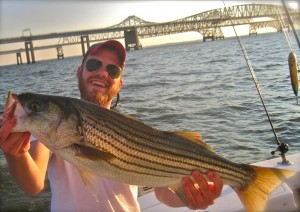 2. Make Mine a Medium – All the successful light tackle fishermen I know use medium or medium-heavy power rods year-round for stripers in the Chesapeake Bay. Unlike in other parts of the striper coast, we don’t have as many strong rips and currents here, so we don’t need heavily weighted lures and industrial strength rods. The lower the rod’s power, the higher the sensitivity. Even though we’re targeting fish that can exceed 50 pounds, rods designed for freshwater bass are easily sufficient. A fishing rod is more than a delivery device for a lure and a cushion against tension when fighting the fish. It’s also a tool for detecting strikes. We’re usually fishing in open water where there are few obstructions like limbs, grass, or vegetation. There’s no need to muscle fish out of cover, but when fishing is tough, every strike is critical. A sensitive medium power rod accompanied by 10- or 15-pound-test line and a smooth drag is all you need to detect strikes, feel the bottom, and quickly land big fish.
2. Make Mine a Medium – All the successful light tackle fishermen I know use medium or medium-heavy power rods year-round for stripers in the Chesapeake Bay. Unlike in other parts of the striper coast, we don’t have as many strong rips and currents here, so we don’t need heavily weighted lures and industrial strength rods. The lower the rod’s power, the higher the sensitivity. Even though we’re targeting fish that can exceed 50 pounds, rods designed for freshwater bass are easily sufficient. A fishing rod is more than a delivery device for a lure and a cushion against tension when fighting the fish. It’s also a tool for detecting strikes. We’re usually fishing in open water where there are few obstructions like limbs, grass, or vegetation. There’s no need to muscle fish out of cover, but when fishing is tough, every strike is critical. A sensitive medium power rod accompanied by 10- or 15-pound-test line and a smooth drag is all you need to detect strikes, feel the bottom, and quickly land big fish.
3. Faster is Better – The terms speed, action, and taper all refer to the same thing – it’s how much the fishing rod bends under pressure. Since we typically jig lures weighing between a half ounce and two ounces, we get better action using a rod with a stiff tip – one that snaps back fast. Fast action rods are also more sensitive because vibrations travel better though a rod when it doesn’t bounce. It’s also easier to set the hook and fight a fish to the boat quickly with a fast rod. The trade off is that you can’t usually cast as far since there isn’t much spring to help propel the lure. That’s okay, because long casts usually aren’t necessary for jigging stripers.
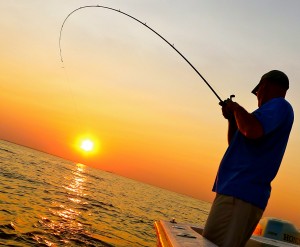 3. Shorter is Sweeter – Since some of the bass tournament all-stars have started using longer rods, and the masses want to fish like the pros, it’s getting hard to find short jigging rods. The rod makers have yet to figure out that there is a huge contingent of light tackle fishermen who will line up for a rod designed specifically for jigging Chesapeake stripers. For the past six years, I’ve bragged about Powell Rods. Unfortunately, they’ve stopped making their 6′ 8″ medium power, extra fast, casting rod that was perfectly tuned for jigging. Rumor has it they may do a short run for Chesapeake fishermen, but I recently ordered a couple of St. Croix rods with those same specs and I’ll keep you posted on how they work out. St. Croix is a bigger company and a bit more insulated against industry fads. I’d rather have a 6′ 6″ rod, but they’re nearly impossible to find anymore. Longer rods cast farther, but they’re less accurate and they aren’t as sensitive. A rod between 6′ and 7′ is perfect for jigging stripers.
3. Shorter is Sweeter – Since some of the bass tournament all-stars have started using longer rods, and the masses want to fish like the pros, it’s getting hard to find short jigging rods. The rod makers have yet to figure out that there is a huge contingent of light tackle fishermen who will line up for a rod designed specifically for jigging Chesapeake stripers. For the past six years, I’ve bragged about Powell Rods. Unfortunately, they’ve stopped making their 6′ 8″ medium power, extra fast, casting rod that was perfectly tuned for jigging. Rumor has it they may do a short run for Chesapeake fishermen, but I recently ordered a couple of St. Croix rods with those same specs and I’ll keep you posted on how they work out. St. Croix is a bigger company and a bit more insulated against industry fads. I’d rather have a 6′ 6″ rod, but they’re nearly impossible to find anymore. Longer rods cast farther, but they’re less accurate and they aren’t as sensitive. A rod between 6′ and 7′ is perfect for jigging stripers.
4. Less Is Best – There’s simply no need for any cork or foam in front of the reel seat on a jigging rod. When you’re jigging, the only time you’ll put your hand there is when you’re palming a baitcaster, so added cork just insulates your fingers against the vibrations caused by strikes. You don’t want it. The more contact your fingers have with the bare rod blank, the better you can tune in to your lure. That’s also why I like open reel seats, so I can get another couple of fingers on the blank below the reel. All you need is enough material to provide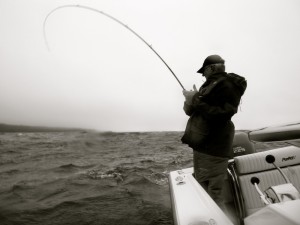 a grip for your hand. Another thing to keep in mind is that lots of added lacquer and decoration might look pretty, but it ultimately reduces sensitivity. Experienced fishermen acquire an advanced sense for the feel of their lures, so less in a rod is always best.
a grip for your hand. Another thing to keep in mind is that lots of added lacquer and decoration might look pretty, but it ultimately reduces sensitivity. Experienced fishermen acquire an advanced sense for the feel of their lures, so less in a rod is always best.
5. Modulus/Smodulus – The term modulus refers to the elasticity of the graphite composite and was coined by a materials company in Delaware called Hexcel. They came up with the terms IM6, IM8, IM10, etc. to distinguish between the individual characteristics of their materials. You can check the specs of each material on their website: http://www.hexcel.com/solutions/industries/isports-equipment but I wouldn’t waste the time. Some rod manufacturers use Hexcel composites while others don’t. One company’s IM10 might be another manufacturer’s IM8.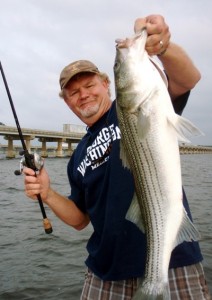 It doesn’t matter anyway, because the better rod companies use a combination of materials. For example, you could buy a rod with an IM6 base, an IM8 body, and an IM10 tip. They might call it an IM10 rod, but it’s really a combination of materials. Another factor is that all rods contain a percentage of fiberglass. How much depends on the proprietary formula of the manufacturer and it’s a closely guarded secret. Some fiberglass is necessary because it adds strength to the rod, but it also reduces sensitivity. To make things even more complicated, there are variances in the type of adhesive that holds all the materials together. Don’t kill yourself trying to decipher all those silly numbers. Just look for a rod that has the right combination of sensitivity, weight, and durability.
It doesn’t matter anyway, because the better rod companies use a combination of materials. For example, you could buy a rod with an IM6 base, an IM8 body, and an IM10 tip. They might call it an IM10 rod, but it’s really a combination of materials. Another factor is that all rods contain a percentage of fiberglass. How much depends on the proprietary formula of the manufacturer and it’s a closely guarded secret. Some fiberglass is necessary because it adds strength to the rod, but it also reduces sensitivity. To make things even more complicated, there are variances in the type of adhesive that holds all the materials together. Don’t kill yourself trying to decipher all those silly numbers. Just look for a rod that has the right combination of sensitivity, weight, and durability.
6. Quality Matters – As with most anything, you get what you pay for when buying a rod. There is a broad range of quality across rod brands. If I chose my rods based only on price, I’d have a shop full of Berkely Lightning Rods. For less than fifty bucks, these rods are incredibly fast, light, and relatively sensitive. But how many last through the first year? Not many because they’re built with cheap materials. The better rod makers use the best materials they can find. When it comes to durability, little things matter. Most rods are still made by hand. Manufacturers buy the materials from composite companies like Hexcel, and hand roll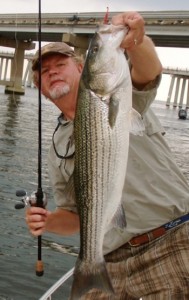 it around a tapered steel mold. Guides, handles, and reel seats made to various quality standards are then added, usually also by hand. As a result, there can be a lot of variance in the quality of a rod, even among the same brand with the same specifications. Look closely before you buy.
it around a tapered steel mold. Guides, handles, and reel seats made to various quality standards are then added, usually also by hand. As a result, there can be a lot of variance in the quality of a rod, even among the same brand with the same specifications. Look closely before you buy.
7. Don’t Get Tricked – One of my first jobs included selling rods at a baitshop. I was pretty good at using all the tricks in the book to convince fishermen they should buy what I had on the shelf. I bet you’ve seen or heard of some of these:
A. The dollar bill trick – It’s world famous, and I still see it in action at the trade shows and flea markets. Lay a dollar bill down on the floor. Rub the tip of the rod over the dollar and feel for the ridges in the paper. Wow, you really can feel them! Of course, you can also feel them with a rake handle.
B. The Hummer – Hold a rod straight out and have a buddy walk up and hold it against his Adams apple while humming softly. Amazing! You can feel every note! Now, try it with a snow shovel. Even better!
C. The Dangle – Dangle a piece of fishing line off the tip of the line and have your buddy flick it lightly with his finger. A variation is to whack it with a broom straw. Whammo! Feels just like a strike.
D. The Wobble – Hold the rod by the reel seat and strike the butt of the rod with your other hand. Watch the wobble. The theory is that a better-made rod will stop vibrating faster. Umm… Okay, compared to what?
E. The Balancing Act – Put your finger under the reel seat of a rod with a reel attached. This works best with a spinning reel. Say, “A perfectly balanced outfit should remain level on your finger.” Well, yeah, but try changing to another kind of reel and you’ll see that all you have to do is move your finger a little and you can still balance it just fine. Remember those butt caps that came out in the 1980s that you put quarters in? Bad idea. You never want to add more weight to a fishing outfit.
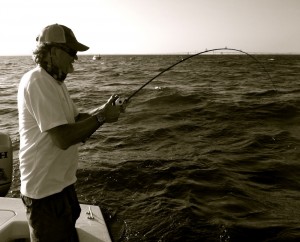 Sensitivity is all relative. Maybe the dollar-bill trick could help you decide between two models, but it’s worthless for evaluating a single rod off the rack. By the same token, a reel that matches the weight of the rod is very important, but it has very little to do with how it balances on your finger.
Sensitivity is all relative. Maybe the dollar-bill trick could help you decide between two models, but it’s worthless for evaluating a single rod off the rack. By the same token, a reel that matches the weight of the rod is very important, but it has very little to do with how it balances on your finger.
Good luck picking out your perfect jigging rod. If you aren’t sure where to start, it helps to talk to experienced anglers, preferably those who fish with the same styles and techniques you do. There are also some excellent custom rod makers around who can make a rod to your exact specifications. Just remember that they’re using blanks and components made by the major manufacturers, so ask about what you’re getting up front.
For topwater, I still like spinning outfits. More on that later!
Fishing Report
“Slowing down” is what I’m hearing from all fronts this week. As usual, fishing pressure during the Independence Day holiday sends the stripers into hiding. Recent rains resulted in heavy runoff and increased stratification in the mid-bay. A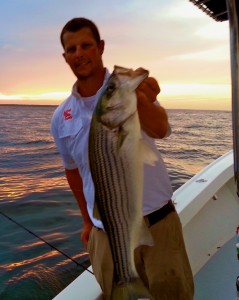 new pattern is still shaking out. Nevertheless, the live-liners and bait guys are still doing very well in the area around north Poplar Island and near Thomas Point. If all I needed to do was put fish in the boat, I’d live-line spot. But since there is a two-fish-per-person recreational limit and you can usually get that in about 15-seconds using bait, I’d just as soon jig.
new pattern is still shaking out. Nevertheless, the live-liners and bait guys are still doing very well in the area around north Poplar Island and near Thomas Point. If all I needed to do was put fish in the boat, I’d live-line spot. But since there is a two-fish-per-person recreational limit and you can usually get that in about 15-seconds using bait, I’d just as soon jig.
I keep hearing stories of people catch & release fishing with live bait – bad idea.
The jigging bite in Eastern Bay has slowed some this week. Finding schools of bigger fish that are willing to take a lure has been a challenge in the mid-Bay. Topwater along the shoreline is next to nothing right now. There are still some fish on the bridge pilings and north from the Sewer Pipe to the mouth of the Chester River. You’re chances are also good by drifting through the live-lining fleet with a jig. You might get some dirty looks, but hey, it’s that time of year. The pattern should shake out in a couple of days. I’ve found plenty of small fish breaking on the surface and my crew has caught a few keepers out of them by throwing a topwater plug with hooks so big that the little ones can’t get them in their mouths.
If you haven’t yet, pick up the July issue of Chesapeake Bay Magazine in which John Page Williams and I share our favorite fishing and boating apps for iPhone and Android. It’s on the news stands now.
Here’s my friend Monica on a fun topwater bite in Eastern Bay last Saturday evening. Monica and Mike joined me and Dianne on Thunder Road for a fishing and fireworks cruise to St. Michaels, Maryland last weekend.




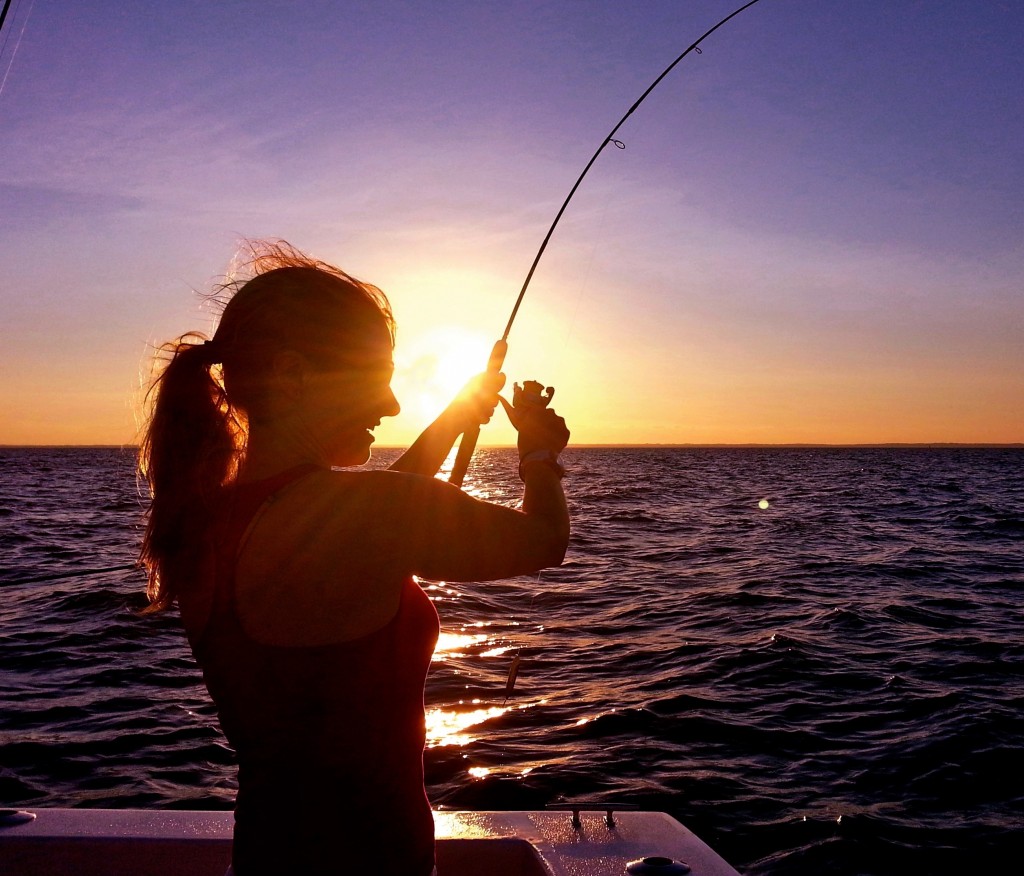
Hey Shawn, you’ve done the research, how about endorsing a rod/reel combo for us mortals. I have very few rigs that I don’t regret for some reason. You know, the blank’s great but the guides suck, the guides are good but the rod’s soft,whatever… You would certainly be doing me and a bunch of others a service if you did this.
More great information here. It took me several years to get comfortable with a baitcaster but no I’ll never go back for the exact reason you mention. I’d also like to know if there is an outfit you prefer above others?
Colin – I should be testing out some new St. Croix rods in the next couple of weeks and I’ll let you know how it turns out. A lot depends on your price point but I will say that for a hundred bucks, I like the St. Croix Mojo Bass series, either the 6’6″ fast or the 6’8″ extra fast model. There are more sensitive rods and there are more durable, but this one is a pretty good balance of both for the price. I’ll be testing their new Rage series.
I’m getting ready to buy a rod for LTJ, finally. I’m curious — you ever finish your testing for a replacement for the 682CEF (e.g. the St. Croix models?
I’ve gone though a bunch of rods, Mike, and I still haven’t found a blank I’m ready to put my name on. Still working on it though.
Hey Shawn, thanks for the tips on selecting a combo that will improve our light tackle angling. But I was wondering, is a medium power rod when jigging essential to feeling strikes and planting good hook sets or is it just what you feel comfortable with in respect to getting fish to the boat and back into the water unscathed? Also I landed a 21 inch redfish this evening casting to some shallow water structure just south of the bay bridge, have you come across any redfish so far this year in the upper bay?
RGM – I like medium power for the sensitivity. Some of my fishing partners use medium heavy rods with good results and it is easier to land a fish with a heavier rod. I wouldn’t consider a heavy rod at all for jigging in the Bay. On several occasions I’ve seen an angler switch to a good quality SENSITIVE rod and start catching fish when he wasn’t before.
Glad to hear about the redfish. I haven’t caught any this year despite targeting them two or three times. I’ll start working them a little harder in August. Appreciate that info.
Shawn thanks for the article it is very interesting.I just picked up your book last week so i am enjoy that.Have to say I have used berkley lightning rods for years, only 2 I had lasted me forever.Use them for bass fishing,shoreline topwater, and baitfishing for stripers.
Good comment, Curtis. Nothing wrong with a Lightning Rod. Most sensitive rod out there for the price. They use an inexpensive resin to hold the graphite composite together, and lesser quality components, but Berkley gets it that a rod needs to be light and fast. Take care of them, and I’m sure you can get some years out of them. I’m not a fan of the Shock series for jigging because of the soft tips.
good stuff Shawn….always amazes me the guys have a really nice boat and fish with rods that are not sensitive
Or fill up the rod holders with gas…
You’re still talkin’ bout fishin’, right?
What size reel would you recommend for this. Is an abu 6500c3 too big to balance with these rods?
It’s a little on the big side for open bay applications, but will certainly work. I’d pair it with a 6′-6″ to 6′-9″ medium heavy, fast action rod for jigging 1.5 ounce baits or heavier. I generally use low profile bass reels for jigging because of the advantage to palming the reel, but I have some traditional round reels as well. I think most of the reels labeled “inshore” are too heavy for open bay applications although they’re making them lighter and lighter.
That is actually very interesting, Shawn.
I loved your book and I’m hoping the video I watched of you today will correct my technique (so that skunking is no longer my norm… 🙁 )
All the best!
Couldn’t find the right 6′ blank, so I/m going w/a GBC 2 Piece Blank 7′.0″ Medium Heavy & might cut it down to 6’6″, but will for sure use a Fuji Fazlite KL guide train.
I’m on Long Island, so probably won’t see you in the Chesapeake, but yell if yr up here …